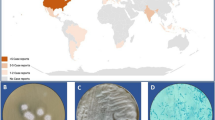Abstract
Malassezia, a skin colonizer, is associated with multiple skin disorders in adults, and cephalic pustulosis and folliculitis in children. It can cause fungemia in infants and neonates. The time and pattern of colonization, risk factors associated with colonization and causing fungemia in children, are not well understood. The prospective cohort study was conducted to determine the rate of Malassezia species colonization and associated factors in hospitalized neonates and infants. Consecutive 50 neonates and infants admitted in neonatal and pediatric intensive care units were studied. The skin swabs were collected on the day of admission and every fifth day, thereafter, till the patient was discharged or died. Putative risk factors for the colonization of Malassezia species were recorded. Isolates were identified by phenotypic methods and sequencing of the D1 and D2 region of rDNA. Neonates were not colonized at the time of entry in neonatal ICU or at birth. Nineteen (38 %) neonates were colonized with Malassezia species during their hospital stay. Among the infants, three (6 %) came to ICU with Malassezia colonization and 26 (52 %) acquired Malassezia during ICU stay. Mechanical ventilation, duration of hospital stay, central venous catheterization, and antifungal therapy were the significantly associated factors for colonization. Malassezia furfur was the most common species isolated from the skin of infants and neonates. Colonization by Malassezia species in infants and neonates in a hospital is not uncommon and can be a potential source of nosocomial infection.


Similar content being viewed by others
References
Groll A, Tragiannidis A. Malassezia fungemia and invasive infections. In: Boekhout T, Gueho E, Mayser P, Velegraki A, editors. Malassezia and the skin. Berlin: Springer; 2010. p. 229–35.
Chang HJ, Miller HL, Watkins N, Arduino MJ, Ashford DA, Midgley G, et al. An epidemic of Malassezia pachydermatis in an intensive care nursery associated with colonization of health care workers’ pet dogs. N Engl J Med. 1998;338(11):706–11.
Chryssanthou E, Broberger U, Petrini B. Malassezia pachydermatis fungemia in a neonatal intensive care unit. Acta Paediatr. 2001;90(3):323–7.
Welbel SF, McNeil MM, Pramanik A, Silberman R, Oberle AD, Midgley G, et al. Nosocomial Malassezia pachydermatis bloodstream infections in a neonatal intensive care unit. Pediatr Infect Dis J. 1994;13(2):104–8.
Ashbee HR, Leck AK, Puntis JW, Parsons WJ, Evans EG. Skin colonization by Malassezia in neonates and infants. Infect Control Hosp Epidemiol. 2002;23(4):212–6.
Ayhan M, Sancak B, Karaduman A, Arikan S, Sahin S. Colonization of neonate skin by Malassezia species: relationship with neonatal cephalic pustulosis. J Am Acad Dermatol. 2007;57(6):1012–8.
Zomorodain K, Mirhendi H, Tarazooie B, Kordbacheh P, Zeraati H, Nayeri F. Molecular analysis of Malassezia species isolated from hospitalized neonates. Pediatr Dermatol. 2008;25(3):312–6.
Gueho E, Boekhout T, Ashbee HR, Guillot J, Van Belkum A, Faergemann J. The role of Malassezia species in the ecology of human skin and as pathogens. Med Mycol. 1998;36(Suppl 1):220–9.
Gueho E, Midgley G, Guillot J. The genus Malassezia with description of four new species. Antonie Van Leeuwenhoek. 1996;69(4):337–55.
Kurtzman CP, Robnett CJ. Identification of clinically important ascomycetous yeasts based on nucleotide divergence in the 5′ end of the large-subunit (26S) ribosomal DNA gene. J Clin Microbiol. 1997;35(5):1216–23.
Yamamoto A, Serizawa S, Ito M, Sato Y. Effect of aging on sebaceous gland activity and on the fatty acid composition of wax esters. J Invest Dermatol. 1987;89(5):507–12.
Ahtonen P, Lehtonen OP, Kero P, Tunnela E, Havu V. Malassezia furfur colonization of neonates in an intensive care unit. Mycoses. 1990;33(11–12):543–7.
Abraham Z, Berderly A, Lefler E. Pityrosporum orbiculare in children. Mykosen. 1987;30(12):581–3.
Faergemann J, Fredriksson T. Age incidence of Pityrosporum orbiculare on human skin. Acta Derm Venereol. 1980;60(6):531–3.
Silva V, Di Tilia C, Fischman O. Skin colonization by Malassezia furfur in healthy children up to 15 years old. Mycopathologia. 1995;132(3):143–5.
Nagata R, Nagano H, Ogishima D, Nakamura Y, Hiruma M, Sugita T. Transmission of the major skin microbiota, Malassezia, from mother to neonate. Pediatr Int. 2012;54(3):350–5.
Bell LM, Alpert G, Slight PH, Campos JM. Malassezia furfur skin colonization in infancy. Infect Control Hosp Epidemiol. 1988;9(4):151–3.
Powell DA, Hayes J, Durrell DE, Miller M, Marcon MJ. Malassezia furfur skin colonization of infants hospitalized in intensive care units. J Pediatr. 1987;111(2):217–20.
Bernier V, Weill FX, Hirigoyen V, Elleau C, Feyler A, Labreze C, et al. Skin colonization by Malassezia species in neonates: a prospective study and relationship with neonatal cephalic pustulosis. Arch Dermatol. 2002;138(2):215–8.
Gupta AK, Kohli Y. Prevalence of Malassezia species on various body sites in clinically healthy subjects representing different age groups. Med Mycol. 2004;42(1):35–42.
Gonzalez-Cuevas A, Alayeto J, Juncosa T, Garcia-Fructuoso MT, Moreno J, Latorre C. Neonatal sepsis by Malassezia furfur. Rev Iberoam Micol. 1999;16(3):158–60.
Marcon MJ, Powell DA. Human infections due to Malassezia spp. Clin Microbiol Rev. 1992;5(2):101–19.
Weiss SJ, Schoch PE, Cunha BA. Malassezia furfur fungemia associated with central venous catheter lipid emulsion infusion. Heart Lung. 1991;20(1):87–90.
Iatta R, Cafarchia C, Cuna T, Montagna O, Laforgia N, Gentile O, et al. Bloodstream infections by Malassezia and Candida species in critical care patients. Med Mycol. 2014;52(3):264–9.
Acknowledgments
We duly acknowledge the Indian Council of Medical Research (ICMR), New Delhi, India, for the financial support for the research proposal and providing financial aid to purchase a DNA sequencer. The study was supported by the Institutional Research Grant, Postgraduate Institute of Medical Education and Research, Chandigarh-160012, India.
Conflict of interest
There are no conflicts of interest to declare for any of the authors in the study.
Author information
Authors and Affiliations
Corresponding author
Rights and permissions
About this article
Cite this article
Gupta, P., Chakrabarti, A., Singhi, S. et al. Skin Colonization by Malassezia spp. in Hospitalized Neonates and Infants in a Tertiary Care Centre in North India. Mycopathologia 178, 267–272 (2014). https://doi.org/10.1007/s11046-014-9788-7
Received:
Accepted:
Published:
Issue Date:
DOI: https://doi.org/10.1007/s11046-014-9788-7




